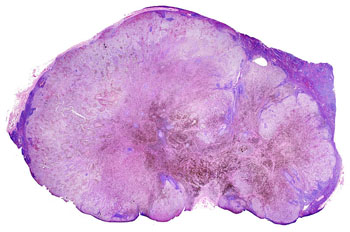Malignant Melanoma Releases MicroRNAs to Condition the Dermis Prior to Metastasis
By LabMedica International staff writers
Posted on 01 Sep 2016
Cancer researchers have discovered that prior to spreading, malignant melanoma sends out packets of microRNAs to induce morphological changes in the dermis to prepare that tissue to receive and transport the cancer cells.Posted on 01 Sep 2016
Melanoma originates in the epidermis and becomes metastatic after invasion into the dermis. However, the interaction between melanoma cells and dermis has not been well studied.

Image: A lymph node with almost complete replacement by metastatic melanoma (Photo courtesy of Wikimedia Commons).
Investigators at Tel Aviv University (Israel) have significantly changed that situation with their report, published in the August 22, 2016, online edition of the journal Nature Cell Biology, that melanoma cells directly affected the formation of the dermal tumor niche by microRNA trafficking before invasion.
MicroRNAs (miRNAs) are a small noncoding family of 19- to 25-nucleotide RNAs that regulate gene expression by targeting mRNAs in a sequence specific manner, inducing translational repression or mRNA degradation, depending on the degree of complementarity between miRNAs and their targets. Many miRNAs are conserved in sequence between distantly related organisms, suggesting that these molecules participate in essential processes. In fact, miRNAs have been shown to be involved in the regulation of gene expression during development, cell proliferation, apoptosis, glucose metabolism, stress resistance, and cancer.
Melanocytes, cells of melanoma origin, are specialized in releasing pigment vesicles, termed melanosomes. In melanoma in situ, the investigators found melanosome markers in distal fibroblasts before melanoma invasion. The melanosomes carried microRNAs into primary fibroblasts triggering changes, including increased proliferation, migration, and pro-inflammatory gene expression, all known features of cancer-associated fibroblasts (CAFs). Specifically, melanosomal microRNA-211 directly targeted IGF2R (Insulin-like growth factor 2 receptor) and led to MAPK (Mitogen-activated protein kinase) signaling activation, which reciprocally encouraged melanoma growth.
The investigators identified two compounds that could prevent conditioning of the dermis by melanosome miRNAs. These potential drugs were SB202190, which inhibited the delivery of the melanosomes from the tumor to the dermis, and U0126, which prevented the morphological changes in the dermis even after the arrival of the melanosomes.
"The threat of melanoma is not in the initial tumor that appears on the skin, but rather in its metastasis - in the tumor cells sent off to colonize in vital organs like the brain, lungs, liver, and bones," said senior author Dr. Carmit Levy, researcher in the department of human molecular genetics and biochemistry at Tel Aviv University. "We have discovered how the cancer spreads to distant organs and found ways to stop the process before the metastatic stage. Our study is an important step on the road to a full remedy for the deadliest skin cancer. We hope that our findings will help turn melanoma into a nonthreatening, easily curable disease."
Related Links:
Tel Aviv University













